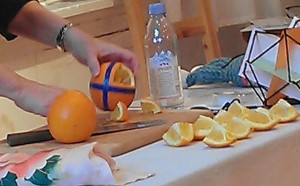Twenty-one brave readers on four continents began the Tetra seminar, Decoding Laban’s Choreutics on March 26th. This “great books” correspondence course is focused on Laban’s posthumously published masterpiece, also known as The Language of Movement.

Over a six-week period, we are exploring the book two chapters at a time. I use the word “exploring” purposefully, for I see this course as a journey of discovery for all twenty-two of us.
It is certainly proving to be a journey of discovery for me. As the guide, I have two tasks. First, I assign questions to provide a focus for each reading assignment. Secondly, I write a commentary on the assigned reading. These commentaries provide background information to help illuminate Laban’s thinking, link themes that recur across chapters, and, in some cases, clarify what Laban appears to be saying.
I have always found some parts of the book to be mystifying. I don’t expect to be able to dispel all the mysteries. However, I am finding that some confusion is due to errors, particularly in the illustrations and notations that accompany them. Perhaps someday an edition of this significant theoretical work can be published with an errata sheet!
For the moment, it is enough to have thoughtful companions and interesting exchange of views as the Tetra takes off.



 Effort is not only about doing; it is also about being, or what Rudolf Laban calls movement thinking. “Movement thinking could be considered as a gathering of impressions of happenings in one’s own mind, for which nomenclature is lacking. This thinking does not serve orientation in the external world but rather it perfects man’s orientation in his inner world.”
Effort is not only about doing; it is also about being, or what Rudolf Laban calls movement thinking. “Movement thinking could be considered as a gathering of impressions of happenings in one’s own mind, for which nomenclature is lacking. This thinking does not serve orientation in the external world but rather it perfects man’s orientation in his inner world.”

 Balloons were distributed to audience members. First they were asked to inflate their balloons by PRESSING the air into the balloon. Next participants were instructed to tie the balloon by WRINGING.
Balloons were distributed to audience members. First they were asked to inflate their balloons by PRESSING the air into the balloon. Next participants were instructed to tie the balloon by WRINGING. The first part of the demonstration illustrates how the cardinal planes divide the kinesphere. To show how the horizontal plane bifurcates the orb of personal space, I chop the orange in half, separating the top and bottom. To show the vertical plane, I chop the orange again, separating front from back. With a bit of manual dexterity, I can slice the rapidly-coming-apart orange one more time, separating the right and left sides, as the sagittal plane does. At this point, the orange falls apart into eight identical pieces. Oui la – the eight zones of the kinesphere!
The first part of the demonstration illustrates how the cardinal planes divide the kinesphere. To show how the horizontal plane bifurcates the orb of personal space, I chop the orange in half, separating the top and bottom. To show the vertical plane, I chop the orange again, separating front from back. With a bit of manual dexterity, I can slice the rapidly-coming-apart orange one more time, separating the right and left sides, as the sagittal plane does. At this point, the orange falls apart into eight identical pieces. Oui la – the eight zones of the kinesphere!

